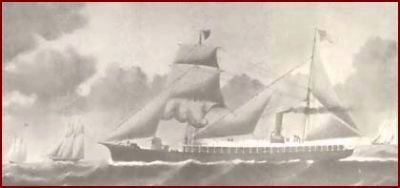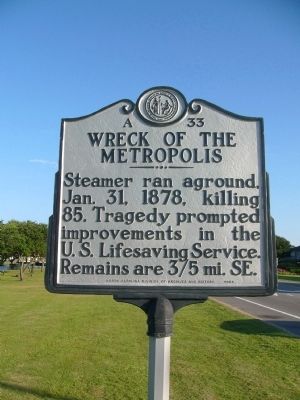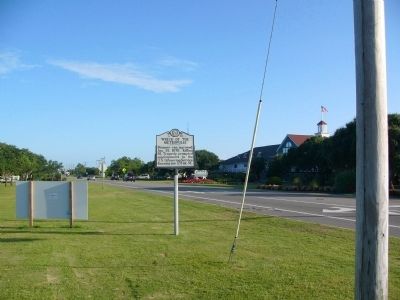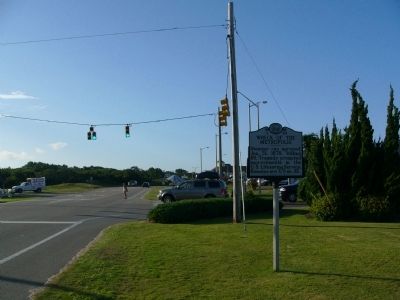Corolla in Currituck County, North Carolina — The American South (South Atlantic)
Wreck Of The Metropolis
Erected 2004 by North Carolina Division of Archives and History. (Marker Number A-33.)
Topics and series. This historical marker is listed in these topic lists: Notable Events • Waterways & Vessels. In addition, it is included in the Lost at Sea, and the North Carolina Division of Archives and History series lists. A significant historical date for this entry is January 31, 1877.
Location. 36° 19.594′ N, 75° 49.051′ W. Marker is in Corolla, North Carolina, in Currituck County. Marker is at the intersection of Ocena Trail (State Highway 12) and Albacore Street, on the right when traveling north on Ocena Trail. Touch for map. Marker is in this post office area: Corolla NC 27927, United States of America. Touch for directions.
Other nearby markers. At least 8 other markers are within 4 miles of this marker, measured as the crow flies. The Knights (approx. 3.3 miles away); Ray T. Adam's Landing Strip (approx. 3.3 miles away); The Whalehead Club Restoration (approx. 3.3 miles away); First Swimming Pool on the Outer Banks (approx. 3.3 miles away); A Nation's Defense (approx. 3.4 miles away); Duck Blinds (approx. 3.4 miles away); Waterfowl Resting Area (approx. 3.4 miles away); The Caretaker's Residence (approx. 3.4 miles away). Touch for a list and map of all markers in Corolla.
Regarding Wreck Of The Metropolis. Copied from http://www.archives.gov/publications/prologue/1987/winter/us-life-saving-service-2.html, an article published in Prologue Magazine, Winter 1987, Vol. 19, No. 4, "The Wreck of the Metropolis" by Dennis R. Means:
Peering through a thick blanket of fog on the morning of January 31, 1878, local fishermen were the first to spot the grounded vessel. There was no time to lose; the steamer would break up fast! Acting quickly, they pulled half a dozen survivors from the sea and dispatched a rider to notify the lifesavers.
Because of the great distance between stations, Surfman William Perry had marched up and down the water-covered beach for several hours through the stormy night and still failed to catch a glimpse of the stricken vessel. He had passed the wreck site on his return patrol about 4:30 a.m.— several hours before the disabled steamer made her run up on the beach or could even be discerned from the shore through the rain.
When the rider, a Mr. Brock, arrived at the lifesaving station about 10 a.m., Keeper
John G. Chappell and his men readied themselves for action. Brock informed him that a vessel was fast breaking up, too fast to get the 750-pound surfboat down the beach to be serviceable. Instead, the keeper strapped the medicine chest to his back and headed for the wreck immediately. His crew of six followed along dragging the beach-cart. Filled with mortar, shot, lines, breeches-buoy apparatus, and a Merriman suit, the cart presented a formidable 1,000 pounds to drag across four and a half miles of soft beach where its broad five-inch-wide tires sank four inches into the sand at every step. (Horses were not kept by stations until 1880.) During the preceding twenty-four hours, each surfman had already patrolled from twelve to thirty-two miles through the dangerous sweeping storm tides. Had a Mr. Dunton with his horse and cart not come to their aid, it is unlikely that the crewmen could have arrived at the wreck site either in time or fit to assist anyone.
After reaching the shore nearest the Metropolis, Keeper Chappell set about the effective application of restoratives to a number of survivors who had already swum ashore. His crew and apparatus arrived about noon. The steamer lay head-in one hundred yards offshore and, thus, presented a small target for the mortar. Nevertheless, the second shot was true and landed across the port fore-topsail yardarm. But the man who
took the line "was no seaman," according to Surfman Piggott Gillikin, and the line was not dropped under the stays and therefore chafed in two before the whip-line could be drawn out to the vessel. Having run out of his own powder, Chappell improvised with some quick-burning black powder that had been secured from Mr. Brock, who lived nearby. But two additional shots failed when each time the shot-line parted from the ball upon firing.
Keeper Chappell then donned the Merriman life-saving dress and made two valiant attempts to carry a line out to the vessel. When he was unable to get past the breakers, those on board the vessel who had looked on in horror began to jump overboard and take their chances at swimming ashore. For three hours keeper and crew struggled to save them in the surf while battling a treacherous undertow; all were badly bruised by the mass of bobbing timbers about them. As Gillikin noted, "all worked as hard at it as possible . . . until it was all over." One hundred and sixty lives were drawn out of the water on that dismal morning.

Photographed By Mariner's Museum, Newport News, VA
4. The Metropolis
The Metropolis was built in 1861 and used to blockade Confederate ports during the Civil War. In January 1878, she was bound for Brazil from Philadelphia, but began leaking off the coast of Delaware before attempting to beach near the Currituck Beach Lighthouse in Corolla, North Carolina on the Outer Banks.
Credits. This page was last revised on June 16, 2016. It was originally submitted on July 28, 2008, by Kevin W. of Stafford, Virginia. This page has been viewed 2,822 times since then and 75 times this year. Photos: 1, 2, 3. submitted on July 28, 2008, by Kevin W. of Stafford, Virginia. 4. submitted on August 16, 2008, by F. Robby of Baltimore, Maryland.


